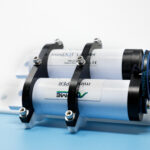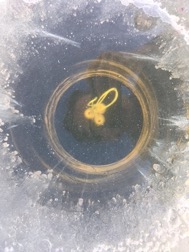
Stream-Aquifer Interactions with Coastal California Watershed
May 20, 2021
Can Kelp Forests be Used to Reduce Ocean Acidification?
August 23, 2021miniDOT® and miniPAR Loggers Used to Measure Arctic Lake Metabolisms
Project Details
- PRODUCT(S): miniDOT® Logger, miniPAR Logger
- APPLICATION: Surface Water
- PARAMETER: Dissolved Oxygen, PAR, Temperature
- LOCATION: Arctic Lakes in Greenland
- ORGANIZATION: University of Maine
- RECOGNITION: Vendy Hazukova

Case Study Description
As climate change continues to melt Arctic ice and increase water temperatures, it is important to understand how ecosystems will respond and change over time. Lakes in the Arctic are covered in a thick layer of ice for most of the year, so we don’t truly know what is happening with lake metabolisms and ecosystems during that time.
Location and Methods
Covering an area of just 10 acres, Lake Anza’s modest size conceals surprising depths. The hypolimnion of the lake, or its lowest level, lay 15 meters below the surface along with layers of sediment and long-dead vegetation. The uppermost 3 meters of Lake Anza receive sufficient oxygenation to support normal ecological function, yet the lower 12 meters of the reservoir are anoxic. Although decomposition slows in anoxic environments, it does not halt entirely; sunken organic material release phosphorus and nitrogen as it breaks down in the hypolimnion. Here, it will remain largely trapped until seasonal temperature changes trigger lake turnover. When water from the lake’s lower levels trades places with water at its higher levels, those nutrients trapped in the hypolimnion are suddenly brought back to oxygenated levels. Thus, the conditions become favorable to support a cyanobacterial algal bloom. Even if a bloom does not occur, Lake Anza can go from vital refuge to veritably poisonous for fish within its waters due to sudden, extreme spikes in phosphorous.
Data Collected
PME’s loggers were favored, according to Hazukova, because “…they are fairly small and very useful for long-term deployments, which is something we are really interested in.”
Hazukova’s study chose the miniDOT Logger because of its ability to take high frequency, precise dissolved oxygen measurements which were vital to the experiment and the understanding of whether photosynthesis or respiration was dominant in each lake. The miniPAR Logger was chosen for its precision in measuring light quantities. The miniPAR was used to determine how much light was actually getting through the thick ice layer.
The data collected from the miniPARs and miniDOTs, deployed for about four months, gave the researchers the information they needed to calculate the lake metabolisms and how they changed over time. The data also provided an easy comparison between summer lake metabolisms and under-ice lake metabolisms.
Another important piece of the data collected was the ability to calculate if algal growth is possible under the ice, which will inform the dissolved oxygen levels of the lake, as well as whether photosynthesis or respiration is more prevalent.
miniWIPERs
The research team attached miniWIPERs to the loggers to prevent biofouling over the four month deployment. Hazukova reported that when the loggers were retrieved, the miniWIPERS kept the sensing surfaces completely clean while the rest of the logger bodies were covered in algae.
For more information on this research project, watch our interview with Vendy Hazukova below.
Product Description
The miniDOT Logger is a completely submersible instrument that logs dissolved oxygen and temperature measurements. The oxygen sensor is an optode that measures dissolved oxygen concentration in water through a fluorescence method. Data are recorded to an internal SD card. Operation of the miniDOT Logger such as setting the time and sample interval can be accomplished via the USB cable.
The miniPAR Logger is a portable, submersible instrument for measuring diffused sunlight through water, or PAR (Photosynthetically Active Radiation). The miniPAR also contains a tilt sensor to ensure proper orientation, as well as a temperature sensor. Data are recorded on an internal SD card.
The miniWIPER is a self-contained, completely submersible, wiping device that can be used with a variety of sensors, including the miniDOT and minPAR Loggers. It can be programmed to wipe at various intervals, and is powered by two AA Lithium batteries. A small brush rotates over the sensor in order to perform a complete wipe of the sensor surface, and then rests away from the sensor to allow for accurate and continuous monitoring. The wiper is used as an anti-fouling device and may reduce the growth of various organisms on the sensor.

